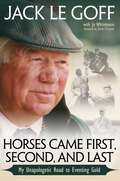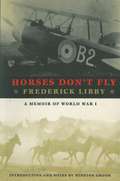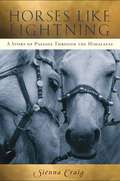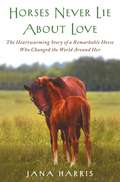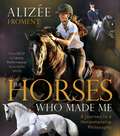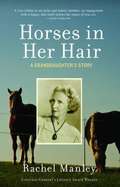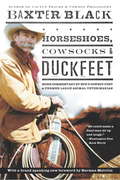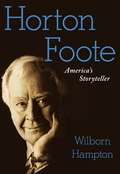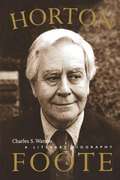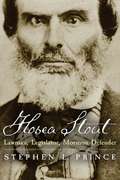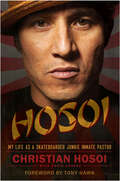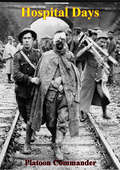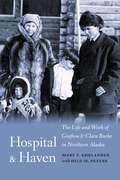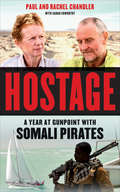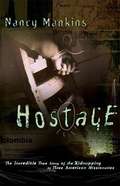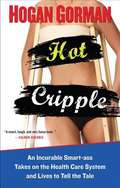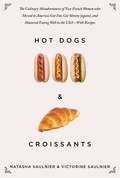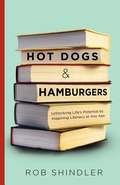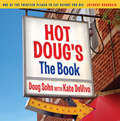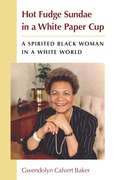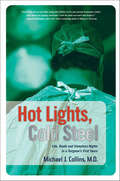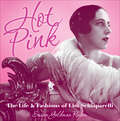- Table View
- List View
Horses Came First, Second and Last
by Jack Le GoffWith an astounding eighteen medals in eight international championships and team gold medals at the Olympic Games in 1976 and 1984, Jack Le Goff created the standard by which modern–day equestrian teams are measured. But Le Goff's techniques could be unforgiving–tough, brutal, and abrasive–earning him critics as well as converts. In this, his autobiography, Le Goff tells the whole story, from impoverished beginnings in Morocco, to the tragic death of his father, to his successes as a competitive equestrian. Readers will enjoy a behind-the-scenes look at the inner workings of high–level international equestrian sport, as well as an entire section devoted to Le Goff's much admired and extremely successful training philosophy.
Horses Don't Fly: The Memoir of the Cowboy Who Became a World War I Ace
by Frederick LibbyFrom breaking wild horses in Colorado to fighting the Red Baron's squadrons in the skies over France, here in his own words is the true story of a forgotten American hero: the cowboy who became our first ace and the first pilot to fly the American colors over enemy lines. Growing up on a ranch in Sterling, Colorado, Frederick Libby mastered the cowboy arts of roping, punching cattle, and taming horses. As a young man he exercised his skills in the mountains and on the ranges of Arizona and New Mexico as well as the Colorado prairie. When World War I broke out, he found himself in Calgary, Alberta, and joined the Canadian army. In France, he transferred to the Royal Flying Corps as an "observer," the gunner in a two-person biplane. Libby shot down an enemy plane on his first day in battle over the Somme, which was also the first day he flew in a plane or fired a machine gun. He went on to become a pilot. He fought against the legendary German aces Oswald Boelcke and Manfred von Richthofen, and became the first American to down five enemy planes. He won the Military Cross for conspicuous gallantry in action. Libby's memoir of his cowboy days in the last years of the Old West evokes a real-life Cormac McCarthy novel. His description of World War I combines a rattling good account of the air war over France with captivating and sometimes poignant depictions of wartime London, the sorrow for friends lost in combat, and the courage and camaraderie of the Royal Flying Corps. Told in charming, straightforward vernacular, Horses Don't Fly is an unforgettable piece of Americana.
Horses Like Lightning: A Story of Passage Through the Himalayas
by Sienna CraigA tender account - by turns cultural exploration and memoir of a young woman's firsthand experience of change and continuity in one of the worlds most remote regions, through the lens of the horse and "horse culture."At nineteen, Sienna Craig made her first venture deep into Mustang, an ethnically Tibetan area of Nepal, in the rainshadow of the Himalayas. As an equestrian and a buddhing anthropologist, she sought not only to understand what it was like to rely on horses to navigate through the windswept valleys and plains of High Asia, but also to grasp how horses lent meaning to the lives of the Mustangi people. Through living and working with local Tibetan doctors, veterinarians, and other horse experts, as well as the deep friendships she formed, Sienna began to understand the region's history, and the way life in Mustang was being transformed in the face of temendous social, political, and economic shifts. She learned much about herself and her life's course through her year in Mustang - a place that came to feel, for all its foreignness, like home.
Horses Never Lie about Love
by Jana HarrisWhen Jana Harris moved with her husband to Washington State for a teaching job, she realized that she could also fulfill her lifelong dream of having a horse farm. And Harris knew the horse on whom she could build her dreams the minute she saw her on a ranch in the Eastern Mountains where a herd had been corralled to be sold: a beautiful, deep dark red-colored mare known as a blood bay, standing about sixteen hands, with a pretty head with a white star and a narrow stripe that slid down her face to two black nostrils. Something about the way the mare guarded her handsome foal, a black two-month-old 200-pound colt, spoke to Harris. The mare was named True Colors. But when True Colors was delivered to Harris's ranch three months later, she was unrecognizable. She had gone feral, run away, and been recaptured. Terrified of people, she was head-shy from the infected sores on her face and her lungs were damaged by smoke-induced pneumonia. She sensed demons hiding in everything from the scent of fabric softener on clothes to a gate in a fence. Her will to escape was enormous. This injured, traumatized horse existed between two worlds--wild and domesticated--and belonged to neither. But there were glimmers of hope: The other horses fell in love with her on sight, just as Harris had. And true to her name and herself, True Colors would never pretend to be something she was not; with her wise, intuitive nature, she would end up changing the lives of everyone she encountered, animal and human. Horses Never Lie About Love is the story of this remarkable horse and the revelations about life and love that she gave Harris over the course of their decades together. Now thirty-three years old, this complex, magnetic animal retains the outsize personality that transforms everyone around her, both human and equine. True Colors has grown to become the heart of the range and the farm, her quiet wisdom transmitting a strength of character that transcends the thin line between animals and the humans they love. There is a famous horseman's saying: A horse never lies about its pain. But maybe we should also consider: A horse never lies about love.
Horses Who Made Me
by Alizee FromentHow a Grand Prix dressage rider competed at the highest level before finding her way to liberty work, and the extraordinary lessons that molded her perceptions, understandings, and feelings along the way.“In my eyes,” says former French international dressage competitor Alizée Froment, “dressage is the journey to perfect communication and absolute harmony between horse and rider.” Her own journey began on the backs of Shetland ponies under the watchful eyes of her mother and then found its way into jumping competitions, and later on, dressage arenas. Along the way, many horses entered and exited her life, each bringing with them a depth of personality that steadily built her understanding of the relationship a rider can build with an equine partner.In her deeply personal and strikingly beautiful book, Froment traces her evolution as a horsewoman, a dressage competitor, and now a world-renowned performer and trainer of liberty horses—horses that perform free of anything on their bodies. Readers meet the ponies she learned on, and the challenging mounts that helped her grow as a junior rider. There were horses she immediately loved and horses she had to work to connect with—and eventually there were Mistral and Sultan, who she calls her “yin and yang,” and who elevated her aspirations both beside and on the back of a horse. It is with these two special souls that Froment further explored riding the Grand Prix movements with only a neck rope—no bridle or bit, and often bareback as well—and demonstrating to the world the potential that is there for all riders to enjoy, if they are open to the experience and are willing to take the time for it to evolve.Readers will be entranced by Froment’s willingness to bare her soul, powerfully articulating her feelings when confronted with jealousy, with performance expectations, with the possibility of losing the horse she loved to an unknown buyer, with retiring a beloved partner, and with the changing circumstances and altered allegiances of her heart when her daughter Louise is born. As tender as a story about riding, competing, and performing with horses at the highest levels can be, The Horses Who Made Me is first a story of one woman’s personal journey, eternally questioning herself, and second, an inspiration for anyone who is forever striving for a better way of training horses, because of the profound beauty you just might find.
Horses in Her Hair
by Rachel ManleyEdna Manley came to Jamaica in 1922 as the wife of a national hero and mother to Jamaica's fifth prime minister. But she had her own contributions to make as artist, mother, wife, behind-the-scenes politician, mystic, and seer. In this intimate biography, her granddaughter Rachel Manley tells Edna's remarkable story from her artistic achievements to the demons that haunted her. Set in imperial England and colonial and postcolonial Jamaica, Horses in Her Hair profiles a larger-than-life figure who left an indelible mark on every culture in which she lived.
Horseshoes, Cowsocks and Duckfeet
by Baxter BlackBaxter Black, the world’s bestselling cowboy poet, author ofCactus Tracks & Cowboy Philosophy, and public radio’s favorite former large animal veterinarian, is back in the saddle with a hilarious new roundup of essays, commentaries, and campfire verse that speaks to the cowboy soul in each of us. Drawn in part from Baxter’s wildly popular NPR commentaries and syndicated columns,Horseshoes, Cowsocks & Duckfeetoffers a generous helping of his tender yet irreverent, sage-as-sagebrush take on everything from ranching, roping, Wrangler jeans, and rodeos to weddings and romance, the love of a good dog, dancing, parenting, cooking up trouble, and talking about the weather. If you haven’t ridden with Baxter before, find out what more than a million dedicated fans are laughing about inside and outside the corral.
Horton Foote
by Wilborn HamptonNo playwright in the history of the American theater has captured the soul of the nation more incisively than Horton Foote. From his Pulitzer Prize-winning play, The Young Man From Atlanta, to his film adaptation of To Kill a Mockingbird, which received an Oscar, millions of people have been touched by Foote's work. He has long been regarded by other playwrights and screenwriters, actors, and cognoscenti of the theater and cinema as America's master storyteller; critics compared him to William Faulkner and Anton Chekhov. Yet Horton Foote's compelling character and rich life remain largely unknown to the general public. His is the story of an artist who refused to compromise his talents for the sake of fame or money, or just to keep working -- who insisted on writing what he regarded as truth, even when for many years almost no one would listen. In the first comprehensive biography of this remarkable writer, Wilborn Hampton introduces Foote to countless Americans who have admired his work. Hampton, a theater critic for The New York Times, offers a colorful, compulsively readable account of a life and career that spanned seven decades. As a child in the small town of Wharton, Texas, Foote's favorite pastime was to listen to the stories his elders told -- about themselves, their families, their neighbors -- around the dinner table or sitting on the front porch. As he once explained: "One thing I was given in life is a deep desire to listen. I've spent my life listening. These stories have haunted me all my life." The stories also served as an inspiration for Foote's life work as he chronicled America's wistful odyssey through the twentieth century, mostly from the perspective of a small town in Texas. Beginning in the Golden Age of Television with dramas such as The Trip to Bountiful, through Broadway and Off-Broadway successes, to the mark he made in films such as Tender Mercies, and right up through a staging of his complete nine-play opus The Orphans' Home Cycle, he documented the struggle of ordinary people to maintain their dignity in the face of hardship and change that the erosion of time inevitably brings. It is a theme Horton Foote lived. Yet the paradox that shines through his work is that while the externals of life alter over the years -- wealth may be gained or squandered, love may be won or lost, friends and relations die -- people themselves do not. Like Eugene O'Neill, Arthur Miller, and Tennessee Williams, Horton Foote's portraits of American life are iconic and true. His stories have helped shape the way Americans see themselves -- indeed, they have become part of the nation's psyche, and they will speak to many generations to come.
Horton Foote: A Literary Biography
by Charles S. WatsonWinner of the Pulitzer Prize for Drama for The Young Man from Atlanta and Academy Awards for the screen adaptation of To Kill a Mockingbird and the original screenplay Tender Mercies, as well as the recipient of an Academy Award nomination for the screenplay of The Trip to Bountiful and the William Inge Lifetime Achievement Award, Horton Foote is one of America's most respected writers for stage and screen. The deep compassion he shows for his characters, the moral vision that infuses his social commentary, and the kindness and humanity that Foote himself radiates have also made him one of our most revered artists--the father-figure who understands our longings for home, for human connections, and for certainty in a world largely bereft of these.
Hosea Stout: Lawman, Legislator, Mormon Defender
by Stephen L. PrinceHosea Stout witnessed and influenced many of the major civil and political events over fifty years of LDS history, but until the publication of his diaries, he was a relatively obscure figure to historians. Hosea Stout: Lawman, Legislator, Mormon Defender is the first-ever biography of this devoted follower who played a significant role in Mormon and Utah history. Stout joined the Mormons in Missouri in 1838 and followed them to Nauvoo, where he rose quickly to become a top leader in the Nauvoo Legion and chief of police, a position he also held at Winter Quarters. He became the first attorney general for the Territory of Utah, was elected to the Utah Territorial Legislature, and served as regent for the University of Deseret (which later became the University of Utah) and as judge advocate of the Nauvoo Legion in Utah. In 1862, Stout was appointed US attorney for the Territory of Utah by President Abraham Lincoln. In 1867, he became city attorney of Salt Lake City, and he was elected to the Utah House of Representatives in 1881. But Stout’s history also had its troubled moments. Known as a violent man and aggressive enforcer, he was often at the center of controversy during his days on the police force and was accused of having a connection with deaths in Nauvoo and Utah. Ultimately, however, none of these allegations ever found traction, and the leaders of the LDS community, especially Brigham Young, saw to it that Stout was promoted to roles of increasing responsibility throughout his life. When he died in 1889, Hosea Stout left a complicated legacy of service to his state, his church, and the members of his faith community. The University Press of Colorado gratefully acknowledges the generous support of the Charles Redd Center for Western Studies at Brigham Young University toward the publication of this book.
Hosni Mubarak and the Future of Democracy in Egypt
by Alaa Al-Din ArafatThe Egyptian revolution of 2011 captivated the world and served as the focal point of the regional uprisings that have collectively come to be known as the Arab Spring. Even now the world waits to see whether the country's elections will aid the progress of liberal democracy or resurgent Islamism. In this essential study, Egyptian scholar Alaa Al-Din Arafat provides a comprehensive look at the political, diplomatic, religious, and socioeconomic factors that were at play in the time leading up to the protests that led to the ouster of Hosni Mubarak. This edition includes a new foreword that reflects on the developments of the last year, providing valuable new context and exploring possible future outcomes.
Hosoi: My Life as a Skateboarder Junkie Inmate Pastor
by Christian Hosoi Chris AhrensA mix of Tony Hawk and Brian Welch comes together in skateboarding legend Christian Hosoi, who reveals everything about his rise, fall, and redemption, in this amazing tell-all—from being named the greatest skater of all time to bottoming out on drugs to finally finding redemption through God.Fans of Slater Kelly’s Pipe Dreams and Brian Welch’s Save Me From Myself, and followers of Tony Alva, Jay Adams, and Steve Caballero, will be captivated by this extraordinary, star-studded story, a gripping read that ranges from the heart of the 1980s skateboarding scene to the inside of a prison, from Hollywood parties to intense prayer sessions.Hosoi: My Life as a Skateboarder Junkie Inmate Pastor takes readers to the heart of one little-known world after another—and he portrays them in all their gore and glory for all the world to see.
Hospital Days
by Arthur F. H. MillsOriginally published under the pseudonym "Platoon Commander" these excellent memoirs were written by the noted novelist Arthur F. H. Mills after his service in the British Expeditionary Force in 1914-1915. Following on from Mill's service in France, he describes his days recuperating from the debilitating wounds he received at La Bassée. His first stop is a field hospital behind the front lines where his leg wound was tended to and a bullet removed; when he was able he was sent on to England. His experiences in the officer's wards of both the army and private hospitals are at once grim and humorous, absent is the disillusionment noted in many memoirs written well after the war.
Hospital and Haven: The Life and Work of Grafton and Clara Burke in Northern Alaska
by Mary F. Ehrlander Hild M. PetersHospital and Haven tells the story of an Episcopal missionary couple who lived their entire married life, from 1910 to 1938, among the Gwich&’in peoples of northern Alaska, devoting themselves to the peoples&’ physical, social, and spiritual well-being. The era was marked by great social disruption within Alaska Native communities and high disease and death rates, owing to the influx of non-Natives in the region, inadequate sanitation and hygiene, minimal law enforcement, and insufficient government funding for Alaska Native health care. Hospital and Haven reveals the sometimes contentious yet promising relationship between missionaries, Alaska Natives, other migrants, and Progressive Era medicine. St. Stephen&’s Mission stood at the center of community life and formed a bulwark against the forces that threatened the Native peoples&’ lifeways and lives. Dr. Grafton (Happy or Hap) Burke directed the Hudson Stuck Memorial Hospital, the only hospital to serve Alaska Natives within a several-hundred-mile radius. Clara Burke focused on orphaned, needy, and convalescing children, raising hundreds in St. Stephen&’s Mission Home. The Gwich&’in in turn embraced and engaged in the church and hospital work, making them community institutions. Bishop Peter Trimble Rowe came to recognize the hospital and orphanage work at Fort Yukon as the church&’s most important work in Alaska.
Hostage: A Year at Gunpoint with Somali Pirates
by Paul Chandler Sarah Edworthy Rachel ChandlerOn October 23, 2009, Somali pirates kidnapped Paul and Rachel Chandler from their sailing boat, the Lynn Rival, in the Seychelles, an archipelago in the Indian Ocean. In this remarkable memoir, the Chandlers recount their terrifying ordeal, revealing the inspiring and poignant story behind the dramatic headlines. The book chronicles the aftermath of the attack, and how the Chandlers' captors held them in Somalia for more than a year while trying to extort millions of dollars from their middle-class family. It goes on to describe how despite enduring threats, intimidation, solitary confinement, and even whippings, their unshakable belief in each other and their determination to survive sustained them. With its detailed, day-to-day account of the experience of being held captive by pirates, this unique and inspiring story will resonate with travelers the world over.
Hostage: The Incredible True Story of the Kidnapping of Three American Missionaries
by Nancy MankinsAs missionaries to the Kuna Indians in Pticuro, Panama, Dave and Nancy Mankins were living their dream. After seven years of learning the culture and ministering among the Kuna, the Mankinses had found a home in this small village. then in one terrifying moment their dream was shattered. On January 31, 1993, Colombian rebels burst into their home and captured Dave, along with fellow missionaries Mark Rich and Rick Tenenoff. Helplessly, their wives watched in horror as the three men were seized at gunpoint and taken into the Colombian jungles. In this riveting story, Nancy Mankins collaborates with the other two wives to create a complete account of the events surrounding their husbands’ abduction. From their first day as missionaries in Pucuro to the agonizing years of working tirelessly to gain their husbands’ release, Hostage is the inspiring account of the women’s courage and faith that continues to sustain them through impossible circumstances.
Hostile Seas: A Mission in Pirate Waters
by Jl SavidgeSet during a period of dramatically escalating piracy, Hostile Seas is a personal account of a mission on board a naval warship in the waters off Somalia. In late 2008, piracy around the Horn of Africa escalated dramatically, threatening the passage of international merchant ships through a critical waterway. Not only were ships carrying goods to North America and Europe affected, but also vessels entrusted with food aid for a Somali population suffering the effects of prolonged drought and civil war.In response, the Canadian government redirected naval frigate HMCS Ville de Québec from the Mediterranean Sea to Somali waters to escort pirate-menaced vessels carrying World Food Programme aid to Mogadishu. Told from the perspective of a ship’s officer, Hostile Seas is a personal account of life on board a deployed navy ship that explores the tension between military imperatives and individual needs as a succession of hijackings brings into focus the reality of Somali piracy.
Hot Cripple: An Incurable Smart-ass Takes on the Health Care System and Lives to Tell the Tale
by Hogan GormanFrom Prada to poverty-one woman's harrowing and hilarious journey Ex-model Hogan Gorman was living the typical New York working actor's life-auditions and classes by day, waitressing and fending off handsy customers by night-when a wise (or just crazy) friend convinced her to ask the universe for a change. And she got one-coming at her at forty miles per hour. Hit by a car and suffering debilitating injuries, and with no health insurance, the fashionista attempts to bounce back into her (thrift store-purchased) Jimmy Choos even as she deals with short-term memory loss, stalker ambulance drivers, trying to stay vegan on food stamps, crazy judges, hot doctors, and unsympathetic government workers. Inspired by her acclaimed one-woman show, this is a bitingly funny and keenly observed account of the cracks in our medical and social welfare system and how one woman's resilience combined with a generous dollop of humor helped her fight her way to recovery. .
Hot Dogs & Croissants: The Culinary Misadventures of Two French Women who Moved to America, Got Fat, Got Skinny (again), and Mastered Eating Well in the USA—With Recipes
by Victorine Saulnier Natasha SaulnierWhen the Saulnier sisters suffer one disappointment too many in their native France, they decide to pack up and try their luck in America. As journalists they have the run of the country, following stories that take them to places where most Americans have never been--from the back roads of Appalachia to an underground village of homeless people in the New York City subway system. Tight on time, and even tighter on budget, the Saulnier sisters slid easily into a drive-thru diet.Along the way they dined on: Nathan's Famous hot dogs at the annual hot dog eating contest in Coney Island Snapping Turtle Soup as prepared by the Native American elders of the Alabama-Coushatta Tribe Cheesy Grits from the Armadillo Diner in Texas And Burgers, burgers, burgers everywhere!As the Saulnier sisters adopted the American way of eating, their relationship to food shortly changes; they soon gain weight--and lose their self-esteem. This new diet is especially hard on Victorine, who temporarily abandons her vegetarianism. It's not until they meet a couple running an organic farm in upstate New York that they realize how far they've strayed from their native food values--and learn that you can eat well in America, too.
Hot Dogs and Hamburgers
by Rob ShindlerLEARNING TO READ BUILDS CONFIDENCE AND HOPE In this heartwarming story, author Rob Shindler tells how he offered his time, unflagging energy, and unconventional teaching techniques to help a boy with serious learning differences and adults suffering from low literacy levels. A father who wanted to help his son with his reading deficiencies, Rob discovered the way to that goal was through volunteering at the Literacy Center of Chicago. There, he learned firsthand how ridiculous the common misconceptions are about learning disabilities and adult illiteracy. The assortment of students he taught were ambitious people who were eloquent, driven, clever, and so funny they made him laugh out loud. Here, Rob shares his students' pain and humiliations, frustrations and hopes. Hot Dogs & Hamburgers demonstrates that literacy issues reside in all neighborhoods and that its victims are committed to finding dignity and life's possibilities through learning to read. Rob's teaching experiences are so motivating and rewarding that once you've read his story, you're likely to begin your own journey as a literacy tutor.
Hot Doug's: The Book
by Kate Devivo Doug Sohn Graham ElliotWhen it comes to hot dogs, Hot Doug's head chef Doug Sohn is the master of the craft. His introduction of gourmet ingredients and professionally trained culinary flair to the world of encased meats has earned him national recognition and praise. In Hot Doug's: The Book, Sohn takes the reader on a fun, irreverent trip through the history of hot dogs, his restaurant, and the many patrons -- both famous and average Joe -- who have declared Sohn the king of dogs.As told through Sohn's own stories, this book will combine photos, favorite anecdotes, lessons learned, and lists ranging from general restaurant etiquette to most-repeated sausage double-entendres (Doug's heard 'em all). Stories included will reveal fact from the folklore of the restaurant's founding, retell the tale of Hot Doug's infamous 2006 run-in with Chicago City Hall, and even provide accounts of Hot Doug's-inspired tattoos, which if presented upon order privilege the bearer to free hot dogs for life. Contributions from some of Hot Doug's biggest fans will be spread throughout the book, with raves from Paul Kahan, Steve Albini, Dan Sinker, Mindy Segal, Homaro Cantu, Aziz Ansari, many other local and national figures, and an introduction from Graham Elliot.
Hot Fudge Sundae in a White Paper Cup: A Spirited Black Woman in a White World
by Gwendolyn Calvert BakerGwendolyn Calvert Baker has had an extraordinary career and has witnessed a dramatic change in the ways that U.S. schools provide education to and about our multiethnic, multicultural society. But Baker hasn't just lived through the progression of multicultural considerations--she has been singularly instrumental in the creation and acceptance of multicultural education. In Hot Fudge Sundae in a White Paper Cup, she shares her memories and experience of a lifetime spent serving and leading the causes for multicultural education.
Hot Lights, Cold Steel: Life, Death and Sleepless Nights in a Surgeon's First Years
by Michael J. Collins“An orthopedic surgeon’s down-to-earth, fast-paced, and frequently funny memoir of his residency [told] with a born storyteller’s skill.” —Kirkus ReviewsMichael Collins’ account of his four-year surgical residency at the famed Mayo Clinic traces his rise from an eager but clueless first-year resident navigating chaos and feelings of inadequacy to accomplished Chief Resident in his final year. With unparalleled humor, he recounts the disparity between people’s perceptions of a doctor’s glamorous life and the real thing: a succession of rundown cars towed to the junk yard, long weekends moonlighting at rural hospitals, a family that grows larger every year, and a laughable income. Collins’ good nature helps him over some of the rough spots—but cannot spare him the harsh realities and heart-wrenching decisions of a doctor’s life. A teenager’s leg is mangled by a tractor: risk the boy’s life to save his leg, or amputate immediately? A woman diagnosed with bone cancer injures her hip: should he recommend a painful operation even though she has only months to live? Unflinching and deeply engaging, Hot Lights, Cold Steel captures the author’s struggles to reconcile his idealism and desire to heal with the recognition of his own limitations and imperfections.“Collins’ life as a surgical resident is heartbreaking one minute and triumphant the next. You’ll laugh and cry and cheer.” —Augusten Burroughs, New York Times–bestselling author of Dry“At once darkly humorous and truly compassionate. Not since House of God has there been such a ferociously funny look at the world of hospital medicine.” —Michael Palmer, New York Times–bestselling author of The Last Surgeon“I adore this book.” —Tess Gerritsen, New York Times–bestselling author of the Rizzoli & Isles novels
Hot Pink: The Life and Fashions of Elsa Schiaparelli
by Susan Goldman RubinShocking pink—hot pink, as it is called today—was the signature color of Elsa Schiaparelli (1890–1973) and perhaps her greatest contribution to the fashion world. Schiaparelli was one of the most innovative designers in the early 20th century. Many design elements that are taken for granted today she created and brought to the forefront of fashion. She is credited with many firsts: trompe l’oeil sweaters with collars and bows knitted in; wedge heels; shoulder bags; and even the concept of a runway show for presenting collections. Hot Pink—printed with a fifth color, hot pink!—explores Schiaparelli’s childhood in Rome, her introduction to high fashion in Paris, and her swift rise to success collaborating with surrealist and cubist artists like Salvador Dalí and Jean Cocteau. The book includes an author’s note, a list of museums and websites where you can find Schiaparelli’s fashions, endnotes, a bibliography, and an index.
